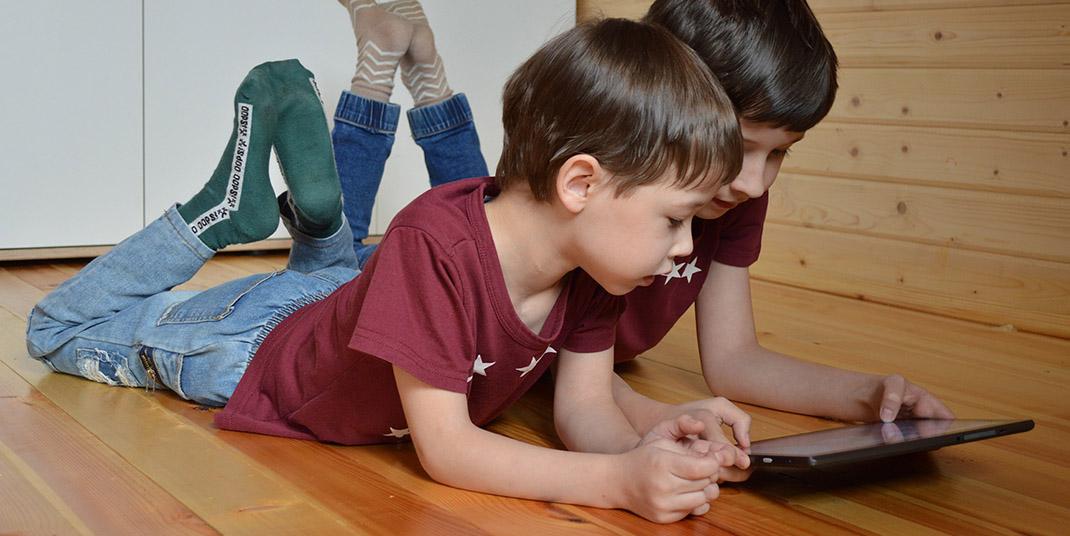Early results of a timely pandemic study by Boston College psychologist Joshua Hartshorne show that increased screen time by children is likely an indicator of family distress.
When the COVID-19 pandemic abruptly changed life for American families due to school and daycare closures, children began spending dramatically more time engrossed with cell phones, computers, and televisions.
“As it turns out, screens are the babysitter of last resort,” Hartshorne explained. “I was surprised how closely the increased screen time results tracked school and daycare closures. It was basically instantaneous."

Joshua Hartshorne
“Screen time is a symptom of a family in distress,” added Hartshorne, who is the study’s co-principal investigator, an assistant professor in BC's Department of Psychology and Neuroscience, and head of the University’s Language Learning Lab. “The COVID data seems consistent. Take parents. Take away child care. Stress and screen time go up.”
Prior to the COVID crisis, increased screen time for youths already was of concern to parents, educators, and policymakers, given its association with negative developmental outcomes. Interventions over the past few decades have focused on educating parents about these dangers and advising them on how to limit screen time.
But during the pandemic, screen time spiked as a direct result of the sudden decrease in adult caretaker availability, according Hartshorne.
“This indicates that lower screen-time rates prior to the pandemic were not merely a function of well-informed parenting but of well-resourced parenting,” he explained. His study, funded by the National Science Foundation, addresses implications for policy and for the ongoing scientific debate about whether screen time is actually problematic for child development.
“Since lockdowns and school closures proliferated in late winter, there has been extensive discussion about their effects on children among policymakers, educators, scientists, parents, and the public at large. People have been particularly concerned about a potential rise in screen time, especially TV and social media,” Hartshorne said.
“We set out to answer two questions. First, is screen time really increasing? Second, why is it increasing? Without answering the second question, it's hard to know what to do about it."
A third question—whether screen time is actually bad for children—will be examined in the second phase of the project. “Despite consensus among the general public, scientists are actually pretty uncertain about that,” he said.
“ The COVID data seems consistent: Take parents. Take away child care. Stress and screen time go up. ”
Hartshorne’s team queried both kids and parents about screen time, through its own surveys and those of other researchers. The team also employed public data sets about COVID and data on actual screen time usage from Reelgood, a company that manages streaming subscriptions.
Findings confirmed the team’s premise that screen time had increased during the pandemic, a dramatic shift in family behavior not due to millions of parents nationwide changing their minds about the dangers of screen time, according to the study, but largely due to lack of child care—a term the team used broadly to include schools—and the resulting stress on parents.
“This matters for the pandemic, obviously,” Hartshorne said. “Policymakers have treated screen time as a public information problem. Not just during COVID, but historically, the primary way of addressing screen time has been teaching parents that it is bad and giving them tips for controlling it. But if screen time is really about parents not having another option, then all these public education campaigns are likely to do is make parents feel bad.”
These conclusions, he said, are of national importance beyond the COVID-19 era.
“We need to be realistic about our options. If we want to decrease screen time among the nation's kids, that may require investing in child care. Either helping parents work shorter hours or providing universal daycare or after school programs. Our study suggests that this is much more likely to work than simply educating parents.”
He cautioned that although the public consensus seems to be that screen time is bad for kids, the data is uncertain and scientists are unsure. “This project was really the first part of a project to use COVID-19 to study whether this huge increase in screen time matters: will we see effects on child development?
Via a related nationwide NSF-funded study, Hartshorne developed and launched a tool to track these effects: the KidTalk app, through which his team is collecting data about development to determine how COVID-19 disruptions—from school closings to canceled playdates—are changing children’s language learning environments. Parents are engaged as “citizen scientists” to create timelines of their children’s evolving speech development: this data will help developmental psychologists better understand language development and how it may be affected by the pandemic.
Hartshorne’s team comprises researchers from the University of Maryland, including co-principal investigator Associate Professor Yi Ting Huang. Like many COVID-19 researchers, they are making their peer-reviewed results available as quickly as possible through preprints. Journal submissions are forthcoming.
Rosanne Pellegrini | University Communications | January 2021




